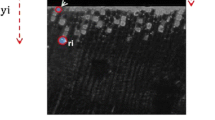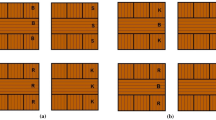Abstract
This paper investigates the wettability of selected wood species from Indonesian community forests, namely (Indonesian name–Latin name) surian (Toona sinensis), jabon (Anthocephalus cadamba), gmelina (Gmelina arborea.), Manglid (Manglietia glauca), rubber wood (Hevea brasiliensis), and sengon (Paraserianthes falcataria). The study measures the contact angle and evaluates the suitability of these wood species for plywood production. Logs from a community forest were processed to convert into thin slices of veneer using the rotary cutting method at a plywood plant. Subsequently, the study analyzed the wetting behavior of the veneer samples resulting from a rotary process on tangential surfaces without smoothing treatment with distilled water. The veneer was then made into plywood using an adhesive nanofiller of phenol formaldehyde mixed with wood bark powder. Ball milling produced nanofillers from the bark of jabon, gmelina, and surian with nanoscale particle diameter size (10–1000 nm). The bonding strength of the plywood was evaluated under cyclic and dry test conditions according to Japanese Standards. The study shows that P. falcataria, H. brasiliensis, and A. cadamba have a smaller contact angle than T. sinensis, G. arborea, and M. glauca. Thus, the higher wettability of P. falcataria, H. brasiliensis, and A. cadamba results in a better adhesive spread and more intimate contact between the wood surface and the adhesive. However, the study found higher bonding strength values for H. brasiliensis and T. sinensis plywood using jabon nanofiller, followed by T. sinensis plywood using surian nanofiller and H. brasiliensis plywood using gmelina nanofiller.








Similar content being viewed by others
References
Alamsyah EM, Liu CN, Yamada M, Taki K, Yoshida H (2007) Bondability of tropical fast-growing tree species I: Indonesian wood species. J Wood Sci 53(1):40–46
Allouche J (2013) Synthesis of organic and bioorganic nanoparticles: an overview of the preparation methods. In: Brayner R, Fievet F, Coradin T (eds) Nanomaterials: a danger or a promise?. A chemical and biological perspective, Springer, London, pp 27–74
Astana S, Parlinah N, Karyono OK, Mulyadin RM (2010) Study of log export policy (text in Indonesian). Center Research and Development of Climate Change and Policy, Forestry Research and Development Board, Ministry of Forestry, Bogor
Bodig J (1962) Wettability related to gluabilities of five Philippine mahoganies. For Prod J 12(6):265–270
Chow S, Steiner PR (1979) Comparisons of the cure of phenol-formaldehyde novolac and resol systems by differential scanning calorimetry. J Appl Polym Sci 23(7):1973–1985
Clemons CM, Caufield DF (2005) Wood flour. In: Xanthos M (ed) Functional fillers for plastics. Wiley, Weinheim, pp 249–270
Collett BM (1972) A review of surface and interfacial adhesion in wood science and related field. Wood Sci Technol 6:1–42
Directorate General of Forestry, Ministry of Agriculture of the Republic of Indonesia (1976) Forestry Vademecum of Indonesia (text in Indonesian), Jakarta.
Ebewele RO (1986) Relationship between phenolic adhesive chemistry and adhesive joint performance: effect of filler type on fraction energy. J Appl Polym Sci 31:2275–2302
Fan M, Dai D, Huang B (2012) Fourier transform infrared spectroscopy for natural fibres. In: Salih S (ed) Fourier transform-materials analysis. InTech, Rijeka, pp 45–68. ISBN 978-953-51-0594-7
FAO (2010) FAOSTAT database home page (https://www.fao.org/). Food and Agriculture Organization of the United Nations, Rome
Freeman HG (1959) Relationship between physical and chemical properties of wood and adhesion. For Prod J 9(12):451–458
Freeman HG, Wangaard FF (1960) Effect of wettability of wood on glue-line behavior of two urea resins. For Prod J 10(6):311–315
Frihart CR (2005a) Adhesive bonding and performance testing of bonded wood products. J ASTM Int 2(7):1–12
Frihart CR (2005b) Wood structure and adhesive strength. In: Goom LH, Stokke D (eds) Characterization of the cellulosic cell wall—the proceedings of the SWST international workshop on the assessment and impact of the cellulosic cell wall. Blackwell Publishing, Oxford
Garside P, Wyeth P (2003) Identification of cellulosic fibres by FTIR spectroscopy-thread and single fibre analysis by attenuated total reflectance. Stud Conserv 48(4):269–275
Hse CH (1972) Wettability of southern fine veneer by phenol formaldehyde wood adhesive. For Prod J 22(1):51–56
Japanese Agricultural Standard [JAS] (2008) Japanese agricultural standard for plywood. The notification no. 1751 of Ministry of Agriculture, Forestry and Fisheries dated 2 Dec 2008
Kampeerapappun P (2012) Preparation characterization and antimicrobial activity of electrospun nanofibers from cotton waste fibers. Chiang Mai J Sci 39:712–722
Karina M (2003) Potential utilization of Acacia mangium: its future in Indonesia. In: Proceeding of the international symposium on sustainable utilization of Acacia mangium, Kyoto, Japan, pp 7–12
Khan MA, Ashraf SM, Malhotra VP (2004) Eucalyptus bark lignin substituted phenol formaldehyde adhesives: a study on optimalization of reaction parameters and characterization. J Appl Polym Sci 92:3514–3523
Kliwon S, and Iskandar MI (1998) Processing of small diameter logs for laminated veneer, veneer and plywood production. In: Proceeding of the second international wood science seminar, Serpong, Indonesia, pp C30–C35
Marchessault RH (1962) Application of infra-red spectroscopy to cellulose and wood polysaccharides. Pure Appl Chem 5:107–130
Marra AA (1992) Technology of wood bonding. Van Nostrand Reinhold, New York
Marsoem SN (2004) Utilization of Acacia mangium plantation forest product (text in Indonesian). In: Hardiyanto EB, Arisman H (eds) Development of Acacia mangium plantation forest: experience in PT. Musi Hutan Persada, Pendopo, pp 301–360
Ministry of Forestry of the Republic of Indonesia (2011) Forestry Statistics of Indonesia 2010 (text in Indonesian), Jakarta
Overney R (2013) Nanothermodynamics and nanoparticle synthesis part 1: nanoparticles and synthesis. NME 498. https://courses.washington.edu/overney/NME498_Material/NME498_Lectures/Lecture%20on%20Thermo%20and%20Nanoparticles%20v5.pdf. Accessed 5 Nov 2019
Poletto M, Zattera AJ, Santana RMC (2012) Structural differences between wood species: evidence from chemical composition, FTIR spectroscopy and thermogravimetric analysis. J Appl Polym Sci 126:E337–E344
Subiyanto B and Firmanti A (2004) Perspective of the sustainable production and effective utilization of tropical forest resource in Indonesia, and the role of LIPI-JSPS core university program. In: Proceeding of the fifth international wood science seminar, Kyoto, Japan, pp 18–24
Sutrisno STS, Alamsyah EM, Purwasasmita BS (2014) Synthesis of bio-based nanomaterial from Surian (Toona sinensis Roem) wood bark using conventional balls milling and its characterization. J Biol Sci 14(3):204–212
Sutrisno STS, Alamsyah EM, Purwasasmita BS (2015) Synthesis and characterization of bio-based nanomaterials from Jabon (Anthocephalus cadamba (Roxb.) Miq) wood bark: an organic waste material from community forest. J Math Fund Sci 47(2):205–218
Sutrisno AEM, Sulistyawati E, Suheri A (2018) The potential use of wood waste ash nanofiller for improvement of laminated veneer lumber production made from Jabon (Anthocephalus cadamba). J Indian Acad Wood Sci 15(2):126–131
TAPPI (2002) 2002–2003 TAPPI test methods. TAPPI Press, Atlanta
Torrey KS (2001) Influence of thermally conductive fillers on the physical properties of waferboard. Master of Science in Chemical Engineering Michigan Technological University
Vick CB (1999) Adhesive bonding of wood materials. In: Wood handbook, wood as an engineering material. Forest Products Society, Madison, pp 9–23
Wellons JD (1980) Wettability and gluability of Douglas-fir veneer. For Prod J 30(7):53–55
Acknowledgements
The authors would like to thank the Directorate of Research and Community Services, Ministry of Research, Technology and Higher Education of the Republic of Indonesia for their financial support under the research scheme of Postdoctoral Research for the Fiscal Year 2018. The authors also thank PT. Sumber Graha Sejahtera, Tangerang, Banten Province, Indonesia, for producing the plywood used in this study.
Author information
Authors and Affiliations
Corresponding author
Additional information
Publisher's Note
Springer Nature remains neutral with regard to jurisdictional claims in published maps and institutional affiliations.
Rights and permissions
About this article
Cite this article
Sutrisno, Widyorini, R., Syamsudin, T.S. et al. Bonding strength of plywood bonded using phenol formaldehyde mixed with wood bark powder nanofiller. J Indian Acad Wood Sci 17, 21–33 (2020). https://doi.org/10.1007/s13196-019-00250-z
Received:
Accepted:
Published:
Issue Date:
DOI: https://doi.org/10.1007/s13196-019-00250-z




